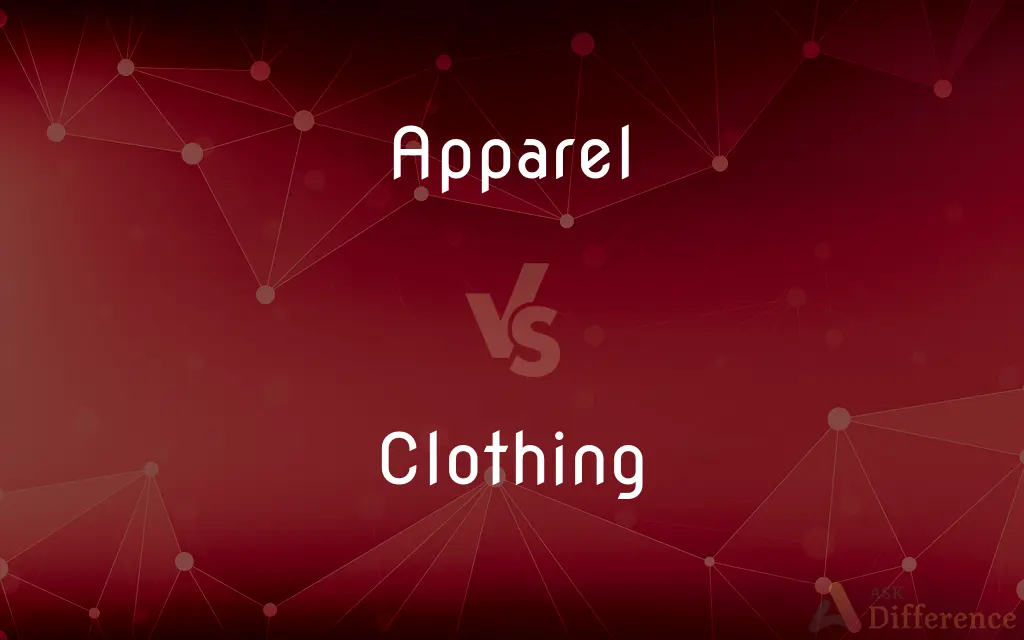Apparel vs. Clothing — What's the Difference?
By Urooj Arif & Fiza Rafique — Updated on March 19, 2024
Apparel emphasizes the fashion or brand aspect of what one wears, whereas clothing simply refers to garments that cover the body.

Difference Between Apparel and Clothing
Table of Contents
ADVERTISEMENT
Key Differences
Apparel often carries connotations of style and fashion, highlighting the items as part of a curated wardrobe or collection. On the other hand, clothing is a more inclusive term, focusing on functionality and necessity without implying any specific style or trend.
While apparel can suggest a level of formality or sophistication, reflecting societal norms and personal identity through fashion, clothing is neutral, encompassing everything from casual wear to formal attire without suggesting a particular quality or purpose.
Apparel is frequently used in the context of marketing and retail, where branding, trends, and seasonal collections play significant roles. Clothing, whereas, is a universal term, applicable in any context where garments are discussed, regardless of the fashion context.
In the fashion industry, apparel may also refer to categories of garments, like sportswear, outerwear, and so on, highlighting the diversity within fashion segments. Clothing, on the other hand, is all-encompassing, not distinguishing between different types or purposes of garments.
While apparel can be seen as an expression of personal or cultural identity through the choice of clothing, accessories, and overall style, clothing serves the primary purpose of protection, modesty, and comfort, emphasizing utility over aesthetic appeal.
ADVERTISEMENT
Comparison Chart
Connotation
Implies fashion, style, and often brand awareness.
Neutral, focusing on the function of covering the body.
Context
More common in fashion and retail sectors.
Universal, used in any context discussing garments.
Purpose
Can suggest a level of sophistication or formality.
Primarily concerned with practicality and necessity.
Fashion Industry
Refers to specific categories of garments (e.g., sportswear, outerwear).
Broad term, encompassing all types of garments without distinction.
Cultural Identity
Often reflects personal or cultural identity through style.
Focuses on the basic need for protection, modesty, and comfort.
Compare with Definitions
Apparel
Sports-related clothing.
The store specializes in golf apparel.
Clothing
Everyday wear.
His clothing choice is casual and comfortable.
Apparel
Designer wear.
She has an impressive collection of luxury apparel.
Clothing
General term for garments.
The charity collected clothing for the homeless.
Apparel
Fashion industry garments.
The brand launched its spring apparel line.
Clothing
Hand-me-down garments.
The siblings shared their clothing.
Apparel
Formal attire for a specific occasion.
The gala required upscale apparel.
Clothing
Protective gear.
Cold weather requires warm clothing.
Apparel
Work uniforms.
The company provides official apparel to all employees.
Clothing
Traditional costumes.
The festival featured traditional Indian clothing.
Apparel
Clothing, especially outer garments; attire.
Clothing
Clothing (also known as clothes, apparel, and attire) are items worn on the body. Typically, clothing is made of fabrics or textiles, but over time it has included garments made from animal skin and other thin sheets of materials and natural products found in the environment, put together.
Apparel
A covering or adornment
Trees with their apparel of foliage.
Clothing
Clothes considered as a group; wearing apparel.
Apparel
To clothe or dress.
Clothing
A covering.
Apparel
To adorn or embellish.
Clothing
Present participle of clothe
Apparel
Clothing.
Clothing
Any of a wide variety of articles, usually made of fabrics, animal hair, animal skin, or some combination thereof, used to cover the human body for warmth, to preserve modesty, or for fashion.
You should wear warm clothing when it is cold outside.
All but two pieces of clothing came out of the washing machine stained.
A poncho is an item of clothing used by many people in Latin America.
A shirt is an article of clothing that covers the torso and arms.
Apparel
(figurative) Aspect, guise, form.
Clothing
An act or instance of putting clothes on.
The clothing and unclothing of the idols was of special significance.
Apparel
A small ornamental piece of embroidery worn on albs and some other ecclesiastical vestments.
Clothing
(obsolete) The art or process of making cloth.
Apparel
(nautical) The furniture of a ship, such as masts, sails, rigging, anchors, guns, etc.
Clothing
A covering of non-conducting material on the outside of a boiler, or steam chamber, to prevent radiation of heat.
Apparel
(transitive) To dress or clothe; to attire.
Clothing
Garments in general; clothes; dress; raiment; covering.
From others he shall stand in need of nothing,Yet on his brothers shall depend for clothing.
As for me, . . . my clothing was sackloth.
Apparel
(transitive) To furnish with apparatus; to equip; to fit out.
Ships appareled to fight
Clothing
The art of process of making cloth.
Instructing [refugees] in the art of clothing.
Apparel
(transitive) To dress with external ornaments; to cover with something ornamental
Trees appareled with flowers
A garden appareled with greenery
Clothing
A covering of non-conducting material on the outside of a boiler, or steam chamber, to prevent radiation of heat.
Apparel
External clothing; vesture; garments; dress; garb; external habiliments or array.
Fresh in his new apparel, proud and young.
At public devotion his resigned carriage made religion appear in the natural apparel of simplicity.
Clothing
See Card clothing, under 3d Card.
Apparel
A small ornamental piece of embroidery worn on albs and some other ecclesiastical vestments.
Clothing
A covering designed to be worn on a person's body
Apparel
The furniture of a ship, as masts, sails, rigging, anchors, guns, etc.
Apparel
To make or get (something) ready; to prepare.
Apparel
To furnish with apparatus; to equip; to fit out.
Ships . . . appareled to fight.
Apparel
To dress or clothe; to attire.
They which are gorgeously appareled, and live delicately, are in kings' courts.
Apparel
To dress with external ornaments; to cover with something ornamental; to deck; to embellish; as, trees appareled with flowers, or a garden with verdure.
Appareled in celestial light.
Apparel
Clothing in general;
She was refined in her choice of apparel
He always bought his clothes at the same store
Fastidious about his dress
Apparel
Provide with clothes or put clothes on;
Parents must feed and dress their child
Common Curiosities
What is apparel?
Apparel refers to garments and items worn on the body, often highlighting fashion and style aspects.
Can the terms apparel and clothing be used interchangeably?
While they can be used interchangeably in some contexts, apparel often carries additional connotations of style and fashion.
How do apparel and clothing differ in usage?
Apparel is often used in fashion contexts emphasizing style, whereas clothing is a more universal term for any type of garment.
What kind of items fall under clothing?
Clothing includes any garments worn on the body, from everyday wear to special occasion attire.
Why is apparel often associated with branding?
Apparel is frequently used in marketing and retail to highlight fashion trends and brand identity.
Can clothing reflect cultural identity?
Yes, though clothing primarily addresses the need to cover the body, it can also reflect cultural traditions and identity.
Is there a difference in the target audience for apparel vs. clothing?
Apparel may target more fashion-conscious consumers, while clothing appeals to a broader audience seeking functional garments.
What is clothing?
Clothing encompasses all types of garments that cover the body, focusing on the practical purpose of wearing them.
Is apparel specific to certain types of garments?
In some contexts, apparel can refer to specific categories within fashion, such as sportswear or designer wear.
Is apparel more formal than clothing?
Apparel can suggest a level of sophistication or formality, but it's not inherently more formal than clothing.
Do apparel and clothing have different purposes?
Apparel may imply fashion-oriented purposes, while clothing primarily serves practical needs like protection and modesty.
How has the perception of apparel and clothing changed over time?
The distinction between apparel and clothing has evolved, with apparel becoming more associated with fashion and identity, and clothing remaining a term for practical and functional garments.
Are accessories considered apparel or clothing?
Accessories are generally categorized separately but can be considered part of apparel in a broader fashion context.
Why might someone prefer the term apparel over clothing?
Using apparel can imply a focus on the aesthetic and stylistic elements of what one wears.
How do the fashion industry and consumers view apparel and clothing differently?
The fashion industry often uses apparel to denote specific styles or collections, while consumers may view clothing as more related to everyday wear.
Share Your Discovery

Previous Comparison
Domain vs. Area
Next Comparison
Emulate vs. MimicAuthor Spotlight
Written by
Urooj ArifUrooj is a skilled content writer at Ask Difference, known for her exceptional ability to simplify complex topics into engaging and informative content. With a passion for research and a flair for clear, concise writing, she consistently delivers articles that resonate with our diverse audience.
Co-written by
Fiza RafiqueFiza Rafique is a skilled content writer at AskDifference.com, where she meticulously refines and enhances written pieces. Drawing from her vast editorial expertise, Fiza ensures clarity, accuracy, and precision in every article. Passionate about language, she continually seeks to elevate the quality of content for readers worldwide.














































